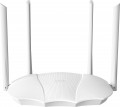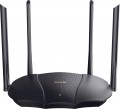2.4 GHz antennas
The total number of antennas in the router that are responsible for communication in the 2.4 GHz band. For details about the number of antennas, see "Total antennas", about the range — "Frequency range".
5 GHz antennas
The total number of antennas in the router that are responsible for communication in the 5 GHz band. For details about the number of antennas, see "Total antennas", about the range — "Frequency range".
2.4 / 5 GHz antennas
The total number of antennas in the router that can operate on both 5 GHz and 2.4 GHz frequencies. For details about the number of antennas, see "Total antennas", about the range — "Frequency range".
Features
The main functions and capabilities implemented in the device.
This category mainly includes the most key functions — namely
load balancing (Dual WAN),
channel reservation,
Link Aggregation,
Bluetooth(various versions, including
Bluetooth v 5),
voice assistant, NAT,
MESH modes,
bridge,
repeater,
Beamforming function ,
firewall (Firewall) and
CLI (Telnet). Here is a more detailed description of each of these items:
— Dual WAN. Possibility of simultaneous connection to two external networks. Most often used for simultaneous work with two Internet connections (although other options are possible); at the same time, there are two main modes of operation with such connections — redundancy (Failover / Failback) and balancing (Load Balance). So, in backup mode, the device constantly uses the main channel to connect to the Internet, and in case of failures on this channel, it automatically switches to a fallback option. In balancing mode, both channels are used simultaneously, while the load between them is distributed either automatically (depending on the traff
...ic consumption of a particular device) or manually (clearly specified in the settings for specific devices). This allows, for example, to separate the channel for online games from the rest of the connection, minimizing lags and increasing efficiency.
— Link Aggregation. A function that allows you to combine several parallel physical communication channels into one logical one — to increase the speed and reliability of the connection. Simply put, with Link Aggregation, a device can be connected to another device not with one cable, but with two or even more at once. The increase in speed in this case occurs due to the summation of the throughput of all physical channels; however, the total speed may be less than the sum of the speeds — on the other hand, combining several relatively slow connectors is often cheaper than using equipment with a more advanced single interface. And the increase in reliability is carried out, firstly, by distributing the total load over individual physical channels, and secondly, by means of "hot" redundancy: the failure of one port or cable can reduce the speed, but does not lead to a complete disconnection, and when the channel is restored, the channel is switched on automatically.
— Bluetooth. The device supports Bluetooth wireless technology. The meaning of this function will depend on the format of the equipment operation (see "Device type"). For example, adapters with this capability allow you to supplement your PC not only with Wi-Fi, but also with Bluetooth support — thanks to this, you can get by with one adapter instead of two. And in routers and access points, this feature allows external devices to access the Internet (or local area network) over a Bluetooth connection instead of Wi-Fi. This format of work allows you to unload the Wi-Fi channel and reduce the power consumption of connected devices; this is especially important for smart home components and other IoT devices, some routers/access points expressly state that Bluetooth is intended mainly for such electronics. Other ways of using this technology, more specific, may be envisaged; however, this is rare.
— Voice assistant. Device support for a particular voice assistant. The most common options are (individually or together):
- Amazon Alexa
- Google Assistant
The specific functionality of these assistants can be clarified from special sources (especially since it is constantly being optimized and expanded). Here we note that in the case of Wi-Fi equipment, we are usually not talking about an assistant built into the device itself, but about improved compatibility with smartphones and other gadgets that have the corresponding assistant installed. Such functionality can be especially useful given that modern voice assistants are also used to control smart home components. Communication with such control is often carried out just through a home router or other similar equipment, and the support of such equipment for voice assistants greatly simplifies setup and expands the capabilities of the entire system.
— NAT (Network Address Translation). A function that allows Wi-Fi equipment, when working with an external network (for example, the Internet), to replace the IP addresses of all computers and other devices connected to this equipment with one common IP address. In other words, a network with such a router is seen "from the outside" as one device, with one common IP. The most popular use of NAT is to connect several subscribers to the Internet (for example, all computers and gadgets within a home or office) through one provider account. At the same time, the number of such subscribers within the network is limited only by the capabilities of the router and can be freely changed; this will not affect access to the World Wide Web (whereas without using NAT, one would have to organize a separate account for each device). NAT support is a mandatory feature for routers (see "Device type").
— Bridge mode. Possibility of operation of the equipment in the bridge mode. This mode allows you to wirelessly connect individual network segments to each other — for example, to combine two floors if it is difficult to lay a cable between them. However, communication over longer distances is also possible — in some directional access points (see "Device type"), created mainly for just such an application, the range can exceed 20 km. Actually, this mode supports most access points (both directional and conventional), but it is also popular in other types of equipment, in particular, routers.
Note that to work in bridge mode, it is best to use the same type of device — this guarantees high-quality communication in both directions. It is also worth mentioning that in addition to the two-way point-to-point mode, there is also equipment with support for multi-way bridges (“point-to-multipoint”); the availability of such a possibility should be clarified separately.
— Repeater mode. An operating mode in which the equipment only repeats the Wi-Fi signal from another device, playing the role of a repeater. The main function of this function is to expand Wi-Fi networks, providing access where the main device (for example, a router) does not reach. A classic example of repeaters is Wi-Fi amplifiers (see "Device type"), they have this mode by definition; however, it is also found in other types of Wi-Fi equipment. The exception is MESH systems that have similar specifics, but differ in the format of work. See below for more information about this format, but here we note that networks with repeaters are in many ways inferior to MESH in terms of practical capabilities. Firstly, the signals from the main equipment and from the repeater are seen as separate Wi-Fi networks, and when moving between them, subscriber devices must reconnect; this can happen automatically, but disconnections and network changes still cause inconvenience. Secondly, working through a repeater significantly reduces the speed of Wi-Fi. Thirdly, the repeater operates according to a strictly fixed, pre-established routing scheme. On the other hand, access points with a repeater function are much cheaper than MESH nodes, and the mentioned drawbacks are far from always critical.
— MESH mode. Ability to operate the device as a MESH network node. By definition, all MESH systems have this feature, but it can be provided in other types of equipment. A detailed description of networks of this type is given in the paragraph “Device type — MESH system”. Here we will briefly describe their features and the difference between this mode and the repeater mode (see above), which has a largely similar purpose.
MESH technology allows you to create a single wireless network using many separate nodes (access points) connected to each other via Wi-Fi. In this case, the so-called seamless mode of operation is implemented: the entire network is seen as a single whole, switching between access points, if necessary, occurs automatically, in such cases the connection is not broken and the user does not notice the transition to another network node at all. This is one of the key differences from using repeaters. Another difference is dynamic routing: MESH network nodes automatically determine the optimal signal traversal mode. Due to this, as well as due to some other features of this technology, the presence of "intermediaries" on the signal path practically does not affect the communication speed (unlike the same repeaters). The main disadvantage of equipment with this function can be called a relatively high cost.
— Beamforming. A technology that allows you to amplify the Wi-Fi signal in the direction where the receiving device is located (instead of broadcasting this signal in all directions or in a wide sector, as is the case in normal mode). Narrowing the radiation pattern allows you to send more power towards the receiver, thus increasing the range and communication efficiency; while the position of the receiving device is determined automatically, the user does not need to deal with additional settings. And many models of Wi-Fi equipment are capable of amplifying the signal in several directions at once (usually, several antennas are provided for this). At the same time, subscriber devices do not have to support Beamforming — communication improvement is noticeable even with the one-way use of this technology (although not as obvious as with the two-way one).
Also note that the unified Beamforming standards were officially implemented as part of the Wi-Fi 5 specification. However “beamforming” was also used in earlier versions of Wi-Fi, however, different manufacturers used different methods for implementing Beamforming, incompatible with each other. So these days, this feature is almost never found outside of Wi-Fi 5 compatible equipment.
— Firewall. A feature that allows a Wi-Fi device to control traffic passing through it. In fact, the Firewall is a set of software filters: these filters compare data packets with the specified parameters and decide whether or not to pass traffic. In this case, the processing can be carried out according to two rules: “everything that is not expressly prohibited is allowed”, or vice versa, “everything that is not expressly permitted is prohibited”. The main function of a firewall is to protect the network (or individual network segments) from unauthorized access and various attacks. In addition, this function can be used to control user activity — for example, prohibitions on access to certain Internet sites. Note that a firewall can also be implemented at the level of individual devices, but using it on a router allows you to secure the entire network at once.
CLI (Telnet). Ability to control the device via Telnet protocol. This is one of the protocols used today to remotely control network equipment; while Telnet, unlike another popular HTTP standard, does not have a graphical interface and uses only the command line. Such access is used mainly for service purposes — for debugging and changing settings in other text-based protocols (HTTP on web pages, SMTP and POP3 on mail servers, etc.); Telnet requires specialized knowledge.
